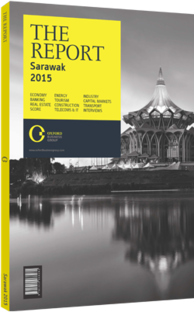OBG talks to Torstein Dale Sjotveit, CEO, Sarawak Energy

Interview: Torstein Dale Sjotveit
How will the power supply meet higher demand from heavy industries during phase two of the Sarawak Corridor of Renewable Energy (SCORE)?
TORSTEIN DALE SJOTVEIT: Demand from the industries already present within SCORE will undoubtedly increase, but we are also driving more demand due to the promotion of SCORE to new customers and industries. The majority of power that is currently being produced is hydropower, hence it is sustainable and priced at a globally competitive bulk power pricing level, which is comparatively low in the ASEAN region. In terms of upcoming supply, the Balingian coal-fired power plant, a RM3bn ($912.6m) investment with a capacity of 600 MW, was recently awarded.
By the end of 2015, one of the two large-scale hydro projects, the Baram and Baleh hydropower projects, will commence early construction work, and each of these will have a capacity of around 1200-1300 MW. In addition, we are currently working on three new combined-cycle gas plants, which together will add another 1500 MW of power to the grid. All of these new developments combined will mean that Sarawak will have approximately 8000 MW installed capacity by the year 2025.
We are also in the middle of constructing a new 500-KV state transmission backbone system, which is another RM3bn ($912.6m) investment that will be completed by the end of 2016, to secure supply to Kuching and customers in SCORE. Thus, I am confident that growth in supply will be able to match growth in demand, and Sarawak will undoubtedly continue to work to attract further industries to SCORE with ample provision of power.
How is Sarawak Energy seeking to diversify its renewable resources portfolio, and how feasible is biomass as an alternative energy in Sarawak?
SJOTVEIT: Sarawak Energy’s portfolio will by mid- to end-2015 consist of 70% renewables, one of the highest percentages of renewable energy for any country in the world. Hydropower remains the focus as a priority renewable energy source, as it is cheaper and more sustainable than any other source. The other three relevant renewable energies up for discussion are biomass, wind and solar, which are completely different in terms of costs. Typical large hydro has a total production cost of $0.05-0.06 per kWh, whereas the cost for other renewable sources ranges from $0.10-0.20, and even much higher, per kWh. Thus, the sustainability of solar and wind is less than that of hydropower, particularly for the economic development of an emerging state.
The other issues associated with these sources is the tropical climate in Sarawak. For efficient wind energy provision, there is a need for stable, prevailing wind throughout the year, whereas tropical winds come in cycles and sporadically, often in combination with large storms, and wind is thus not suitable for power in tropical areas. Solar efficiency is also low in tropical areas due to high levels of cloud and rain. Furthermore, with solar energy there is a need to recharge batteries every two to four weeks and another power source is required to recharge them.
To take a comparative example, to replicate the 20 TWh of power from Bakun with solar power, you would need 500 sq km of solar panels – nearly the same size as Singapore – and roughly RM100bn ($30.42bn) in investment. The replacement of batteries after five to six years would add RM10bn-20bn ($3.04bn-6.08bn). That being said, we are using solar in combination with mini-hydro or diesel to generate electricity in remote areas.
Biomass is, however, offering interesting potential for Sarawak, even if the price of power from biomass typically would be around $0.10 per kWh. Biomass is something we are pursuing. Sarawak Energy signed a renewable energy power purchase agreement with Olive Energy to build a 10 MW plant. Biomass effectively creates energy out of waste that would otherwise have high environmental and economic costs.
How are the economic gains from large-scale hydropower projects being balanced with the social and environmental effects of development?
SJOTVEIT: Any development, whether we are talking about energy, industry or infrastructure, has both positive and negative sides. Sarawak is successfully utilising its natural resources to create a foundation for work and wealth for the present and future generations of Sarawakians, but, of course, the cost is the social impact on the people affected by these large-scale projects. Our job is to find a balance in making sure that the people impacted by these projects are given fair treatment, as well as ample opportunities for change and improvements in livelihood.
Those affected by the Murum project – the 1500 people that were resettled – now have modern housing, access to clean water and power, schools for their children, as well as agriculture land and training, all of which are critical social infrastructure to which they did not have access prior to the project. The long-term benefits of these hydropower projects thus should not be overlooked, although we respect and understand that this kind of development and change may be difficult for many, and every step is being taken to ensure fair and inclusive treatment.
Can the deal to export power to West Kalimantan increase energy cooperation among Brunei Darussalam, Indonesia, Malaysia, Philippines-East ASEAN Growth Area (BIMP-EAGA) members?
SJOTVEIT: The agreement between Sarawak Energy and Perusahaan Listrik Negara (PLN), the national electricity company in Indonesia, is an important one to both nations involved, as well as the greater ASEAN region. The deal, through which Sarawak would be delivering up to 230 MW of renewable energy for five years to West Kalimantan, will result in the Indonesian state replacing diesel with renewable energy, enabling gross savings of $1.2bn for PLN in diesel costs. Furthermore, the CO emissions coming from West Kalimantan will be reduced immensely as a result of this export and the subsequent switch to renewable energy. In terms of further cooperation with other nations and regions within BIMP-EAGA, there is scope and potential for further extension of linkages to Brunei Darussalam, Sabah and Kalimantan on the island of Borneo, as well as other regions in the greater area including Peninsular Malaysia and the Philippines. Despite the geographic and geopolitical challenges of such cooperation, I am confident that greater connectivity will be possible in the region sometime in the near future.
How can Sarawak Energy further capitalise on its strong credit ratings to continue expanding the state’s energy capacity?
SJOTVEIT: Sarawak Energy is blessed with a stable ownership structure, and we have an “AA1” credit rating, which allows for quite inexpensive funding under the current sukuk, or sharia-compliant bond, programme. We believe we will be able to expand this programme to a level that is sufficient to fund the next phase of SCORE which involves the planned new hydro, coal and gas power stations. The primary focus remains to develop phase two of SCORE and the Sarawak grid, and given strong cash flows there should be no barriers to making this a reality.
What initiatives are under way to further explore new ways to deliver energy to rural areas?
SJOTVEIT: Over the four-year period from 2010 to 2014, rural electrification in Sarawak increased from 66% to over 85%, which is the result of enormous investment stemming from the government’s rural programmes. The systems of power delivery that are being used are mainly grid connection, as well as mini-hydro and solar-diesel hybrids. It is just a matter of extending and building more rural stations to connect as many areas as possible. By 2017, we believe the grid will reach 95% of Sarawak’s rural population.
You have reached the limit of premium articles you can view for free.
Choose from the options below to purchase print or digital editions of our Reports. You can also purchase a website subscription giving you unlimited access to all of our Reports online for 12 months.
If you have already purchased this Report or have a website subscription, please login to continue.

